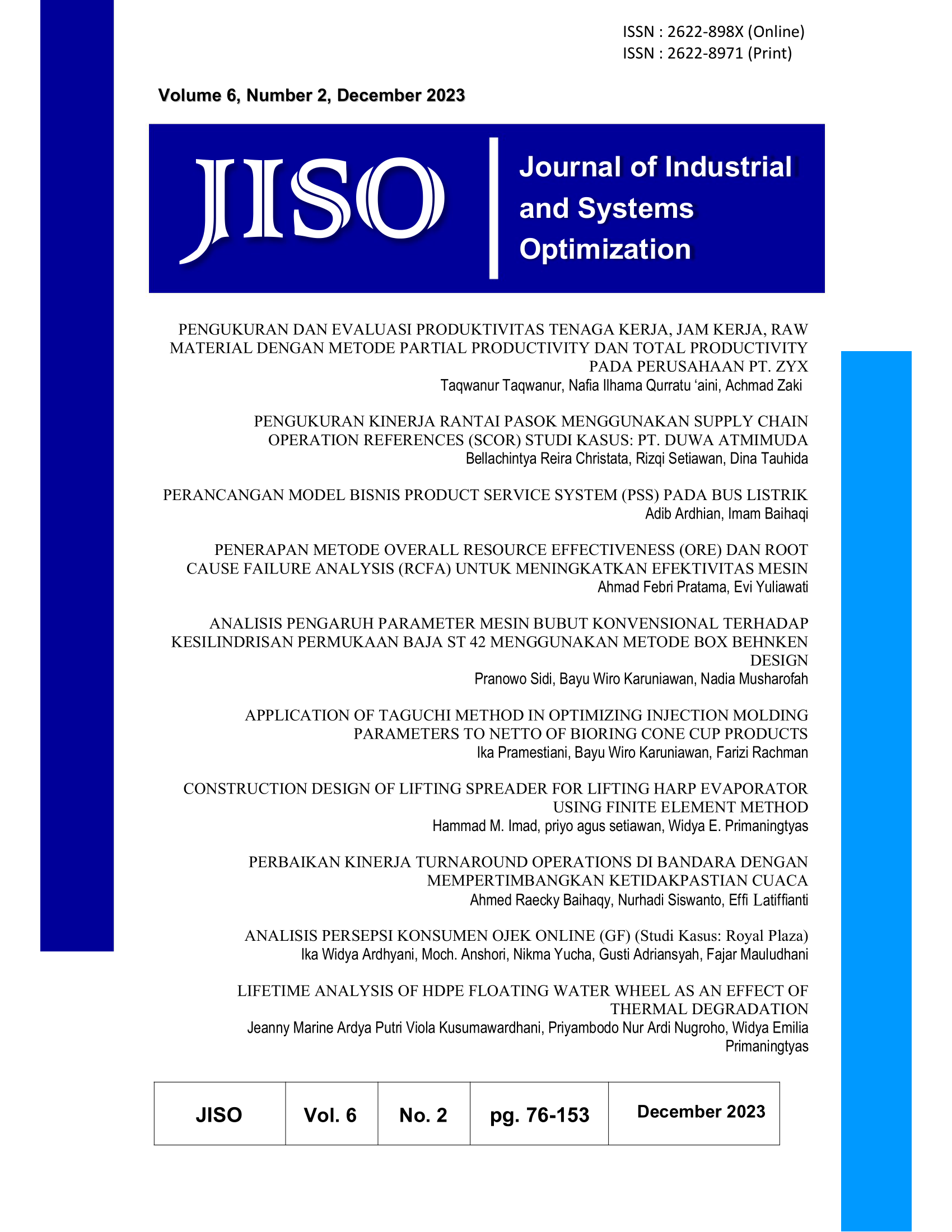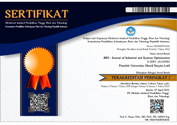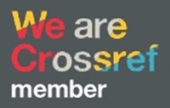APPLICATION OF TAGUCHI METHOD IN OPTIMIZING INJECTION MOLDING PARAMETERS TO NETTO OF BIORING CONE CUP PRODUCTS
DOI:
https://doi.org/10.51804/jiso.v6i2.117-123Keywords:
Cooling Time, Injection Pressure, Injection Temperature, Netto, TaguchiAbstract
Bioring Cone Cup products are produced by Sukodono molding industry with injection molding machine. However, at the beginning of production in getting the parameter value still uses a trial and error system, so this problem results in defects that cause the weight of the product is not in accordance with the agreement so that this product must be recycled again by spending a long time. With this problem, the company suffered losses because it had to pay compensation for production delays. So that research is needed that discusses the optimization of injection molding parameters on the net response of bioring cone cup products. This research uses the parameters of injection pressure, injection temperature, and cooling time. The method used is taguchi with signal to noise ratio criteria, namely smaller is better to determine the effect of factors and also the optimal parameters for the production process. From the experimental results, the optimal combination of variables is obtained, namely the injection pressure parameter at level 1 with a value of 80 bar, injection temperature at level 3 with a value of 230 , and cooling time at level 3 with a value of 0.5 seconds.
Produk Bioring Cone Cup diproduksi oleh industri molding Sukodono dengan mesin injection molding. Namun pada awal produksi dalam mendapatkan nilai parameter masih menggunakan sistem trial and error, sehingga permasalahan ini mengakibatkan adanya cacat yang menyebabkan berat produk tidak sesuai kesepakatan sehingga produk ini harus didaur ulang kembali dengan menghabiskan waktu yang cukup lama. Dengan permasalahan tersebut, perusahaan ini mengalami kerugian dikarenakan harus membayar kompensasi keterlambatan produksi. Sehingga dibutuhkan penelitian yang membahas optimalisasi parameter injection molding terhadap respon netto produk bioring cone cup. Penelitian ini menggunakan parameter injection pressure, injection temperature, dan cooling time. Metode yang digunakan adalah taguchi dengan kriteria rasio signal to noise yaitu smaller is better untuk mengetahui pengaruh factor dan juga parameter yang optimal untuk proses produksi. Dari hasil eksperimen, didapatkan hasil kombinasi variabel yang optimal yaitu parameter injection pressure pada level 1 dengan nilai 80 bar, injection temperature pada level 3 dengan nilai 230 , dan cooling time pada level 3 dengan nilai 0,5 detik.
References
Admadi, B., & Arnata, I. W. (2015). Teknologi Polimer. Bali: Universitas Udayana.
Fathoni, M. A., Waluyo, B., & Sedyono, J. (2015). Analisa Pengaruh Parameter Terkanan terhadap Cacat Warpage dari produk injection molding berbahan polyperila. Skripsi S1 Teknik Mesin, Universitas Muhammadiyah Surakarta.
Gupta, M. K., Mia, M., Pruncu, C. I., Khan, A. M., Rahman, M. A., Jamil, M., et al. (2020). Modeling and performance evaluation of Al2O3 MoS2 and graphite nanoparticle-assisted MQL inturning titanium alloy: An intelligent approach. Journal of the Brazilian Society of Mechanical Sciences and Engineering, 42(4), 1-21.
Kamarudin, M. H., Ibrahim, M. I., Asmawi, R. M., Muhamud, R. I., & Ibrahim, M. H. (2021). Parameter Optimazation of Injection Molding Using High Density Polyethylene-Pineapple. Journal of Advanced Manufacturing Technology (JAMT), Volume ISSN: 1985-3157.
Karunia, Y., Purwanti, E. P., & Karuniawan, B. W. (2020). Analisa Pengaruh ParameterInjection Moulding pada Produk Head Travel Kit terhadap Cycle Time dan Netto menggunakan metode Respon Surface. Conference Design and Manufacture. Surabaya: PPNS.
Karuniawan, B. W., Rachman, F., & Setiawan, A. A. (2019). Optimization of Fused Deposition Modeling (FDM) Machine Parameters on Product Surface Roughness Using the Taguchi Method. Techno Bahari Journal, Volume 6, Number 2.
Mufid, A. K., Budiyantoro, C., & Rahman, M. B. (2017). Perancangan Injection Moulding dengan Sistem Three Plate. JMPM: Jurnal Material dan Proses, pp. 72-81.
Cuan, I. G. (2020). Mengenal HIPS, keuntungan dan pengaplikasian nya. Retrieved Juni 20, 2023, from PT Cuan Plastik Web Site: https://www.cuanplastics.com/news/read/mengenal-hips-keuntungan-dan-pengaplikasian-nya
Pujari, G. V., & Naik, V. R. (2016). Optimization Of Parameters & Minimization Of Defect By Applying Taguchi & Moldflow Method For Injection Molding Component. International Journal of Advanced Technology in Engineering and Science, 03, 01. 95 – 101.
Purnomo, M. H., Sidi, P., & Arumsari, N. (2017). Analisa Pengaruh Parameter Proses Injection Moulding terhadap Berat Produk Cap Lem Fox Menggunakan Metode Taguchi. Diploma Thesis, Politeknik Perkapalan Negeri Surabaya.
Rachman, F., Setiawan, T. A., Karuniawan, B. W., & Maya, R. A. (2019). Penerapan Metode Taguchi Dalam Optimasi Parameter Pada Proses Electrical Discharge Machining (EDM). J Statistika, Vol. 12, No. 1, Hal. 7-12.
Soejanto, I. (2009). Desain Eksperimen dengan Metode Taguchi. Yogyakarta: Graha Ilmu.
Yanto, H., Saputra, I., & Satoto, S. W. (2018). Analisa Pengaruh Temperatur dan Tekanan Injeksi Moulding terhadap Cacat Produk. Jurnal Integrasi, Volume 10 No. 1, pp. 1-6.
Downloads
Published
Issue
Section
License
Copyright (c) 2023 JISO : Journal of Industrial and Systems Optimization

This work is licensed under a Creative Commons Attribution-ShareAlike 4.0 International License.
With the receipt of the article by JISO Editorial Board and the decision to be published, the copyright regarding the article will be transferred to JISO. The copyright transfer form can be downloaded here.
JISO has the right to multiply and distribute the article and every author is not allowed to publish the same article that was published in this journal.
JISO is licensed under a Creative Commons Attribution-ShareAlike 4.0 International License.
Under the following terms:
Attribution — You must give appropriate credit, provide a link to the license, and indicate if changes were made. You may do so in any reasonable manner, but not in any way that suggests the licensor endorses you or your use.
ShareAlike — If you remix, transform, or build upon the material, you must distribute your contributions under the same license as the original.














